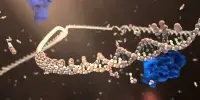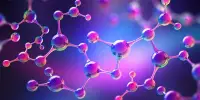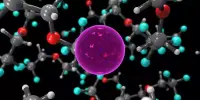Chemists have discovered a way to make molecules known as acenes more stable, allowing them to create acenes of different lengths. They were able to create molecules that produce red, orange, yellow, green, or blue light using their novel approach, which could make acenes more useful in a variety of applications.
Chains of fused carbon-containing rings exhibit unique optoelectronic features that make them valuable as semiconductors. These chains, known as acenes, can also be adjusted to emit different colors of light, making them suitable for use in organic light-emitting diodes.
The color of light emitted by an acene is determined by its length, but as the molecules become longer, they also become less stable, which has hindered their widespread use in light-emitting applications.
Red emission is very important for wide-ranging applications, including biological applications like imaging. A lot of human tissue emits blue light, so it’s difficult to use blue-fluorescent probes for imaging, which is one of the many reasons why people are looking for red emitters.
Dr. Gilliard
MIT researchers have developed a method to make these molecules more stable, allowing them to create acenes of different lengths. They were able to create molecules that produce red, orange, yellow, green, or blue light using their new method, which could make acenes more widely used in a variety of applications.
“Despite their utility, this class of molecules faces challenges in terms of their reactivity profile,” says Robert Gilliard, Novartis Associate Professor of Chemistry at MIT and senior author of the new work. “What we tried to address in this study first was the stability problem, and second, we wanted to make compounds where you could have a tunable range of light emission.”
MIT research scientist Chun-Lin Deng is the lead author of the paper, which appears today in Nature Chemistry.

Colorful molecules
Acenes consist of benzene molecules — rings made of carbon and hydrogen — fused together in a linear fashion. Because they are rich in sharable electrons and can efficiently transport an electric charge, they have been used as semiconductors and field-effect transistors (transistors that use an electric field to control the flow of current in a semiconductor).
Recent research has revealed that acenes having certain carbon atoms substituted, or “doped,” with boron and nitrogen have even more beneficial electrical characteristics. However, when exposed to air or light, these molecules, like typical acenes, become unstable. Acenes are frequently manufactured in a sealed container known as a glovebox to protect them from air exposure, which might cause them to degrade. Acenes are increasingly sensitive to undesirable reactions induced by oxygen, water, or light as they age.
To try to make acenes more stable, Gilliard decided to use a ligand that his lab has previously worked with, known as carbodicarbenes. In a study published last year, they used this ligand to stabilize borafluorenium ions, organic compounds that can emit different colors of light in response to temperature changes.
Gilliard and his co-authors created a unique synthesis for this study that allowed them to add carbodicarbenes to acenes that were also doped with boron and nitrogen. The acenes became positively charged after the addition of the new ligand, which increased their stability and gave them unusual electrical characteristics.
Using this method, the researchers synthesized acenes with varying hues based on their length and the sort of chemical groups connected to the carbodicarbene. Until now, the majority of boron, nitrogen-doped acenes produced could only generate blue light.
“Red emission is very important for wide-ranging applications, including biological applications like imaging,” Gilliard says. “A lot of human tissue emits blue light, so it’s difficult to use blue-fluorescent probes for imaging, which is one of the many reasons why people are looking for red emitters.”
Better stability
Another noteworthy property of these acenes is their stability in both air and water. Boron-containing charged molecules with a low coordination number (meaning the central boron atom has few neighbors) are frequently highly unstable in water, therefore the acenes’ water stability is significant and may allow them to be used for imaging and other medical purposes.
“One of the reasons we’re excited about the class of compounds reported in this paper is their ability to be suspended in water.” “It opens up a whole new world of possibilities,” Gilliard explains.
The researchers now plan to try incorporating different types of carbodicarbenes to see if they can create additional acenes with even better stability and quantum efficiency (a measure of how much light is emitted from the material).
“We think it will be possible to make a lot of different derivatives that we haven’t even synthesized yet,” Gilliard says. “There are a lot of optoelectronic properties that can be dialed in that we have yet to explore, and we’re excited about that as well.”
Gilliard also intends to collaborate with Marc Baldo, an MIT electrical engineering professor, to test the novel acenes in a form of solar cell known as a single-fission-based solar cell. This form of solar cell can generate two electrons from a single photon, making it far more efficient.
Gilliard believes that these compounds could be developed for use as light-emitting diodes for television and computer screens. Organic light-emitting diodes are lighter and more flexible than regular LEDs, and can generate brighter images while using less power.















